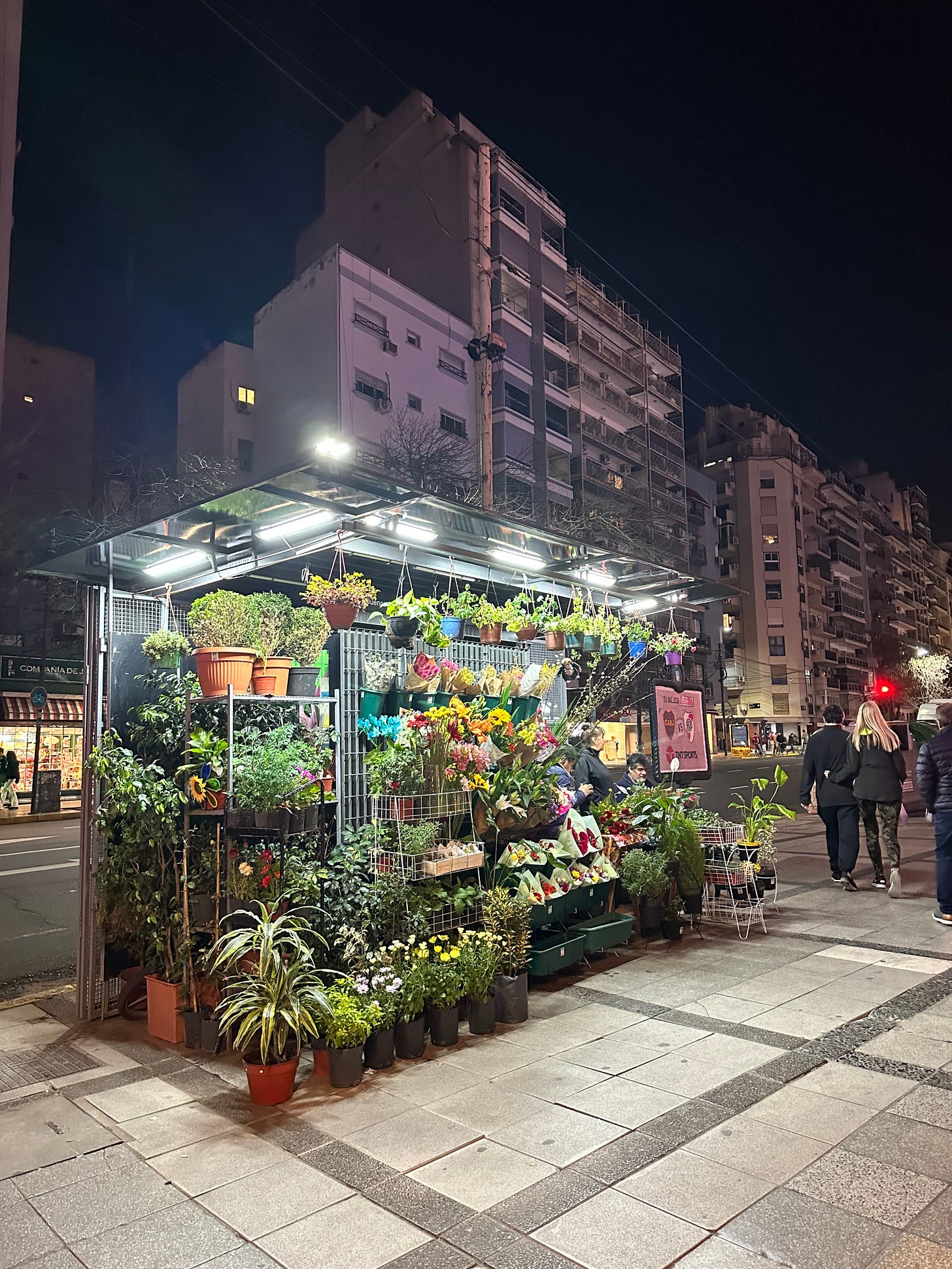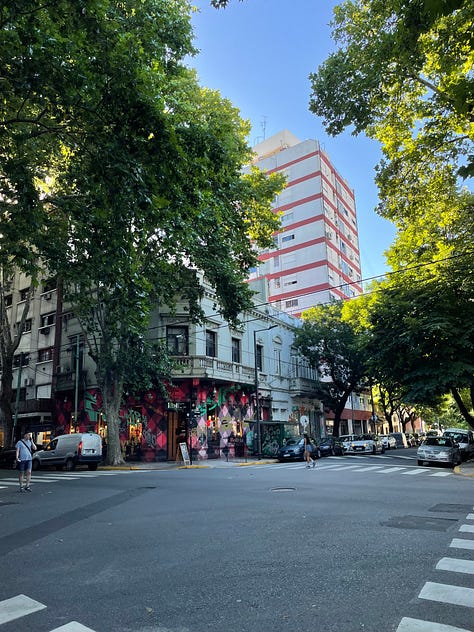Buenos Aires, my other New York.
Once you've lived in and loved a big city, do they all feel like home?

As I sit here typing in an airy coffee shop full of plants and people on their laptops, the smell of dog poop wafting in the open window and horns honking outside, I can’t help but feel at home. Nope, it’s not New York — it’s Buenos Aires, the city that should really get to own the catchphrase “the city that never sleeps.”
Almost every time I’ve traveled to a big city in another country, I’ve thought: I could live here. Because once you’ve lived in New York, I feel like you can plug and play in any metropolis. There’s a sense of order and anonymity in big cities that’s familiar, and predictably unpredictable. Everything is within reach, and anything goes. All you really need are your own two feet. (In other big cities in the US, however, I feel the opposite. They’re not walkable, they’re isolating, and their charm and character are limited to the few walkable bits. Yes, I’m looking at you, LA. It’s a hot take but I stand by it.)
Anyway, back to BA. BsAs. Baires.
Buenos Aires has a special hum that reminds me of New York and prompts people to call it — like my other concrete love — the greatest city in the world.
It’s not the architecture (they compare it to Paris for that) nor the weather (though with global warming, I do think the climates of BA and NYC are becoming more and more similar). And it’s not necessarily the people or the speed (Argentines are a million times more relaxed than New Yorkers, in my humble opinion). It’s just the energy, the vibe, the way people talk about it. The way I’m talking about it now. They both have their shortfalls: crappy, stinky sidewalks; failable public transport; ridiculous housing prices for shoeboxes built with paper-thin walls. New York is covered in urine, Buenos Aires in unscooped dog poo. But they also have incredible coffee shops, tree-lined streets that make you want to spin while staring straight up, and that feeling like you’re in the center of the universe.
Though each city is absolutely unique, I’ve found they both feel like home to me now. I spent about 6 years living in New York, and only about 8 months in Buenos Aires, split up into chunks and over a dozen different Airbnbs. BA has become a sort of launch pad for Ian and I while traveling around South America. Much of his family is here, so we return often for birthdays, special occasions, and breathers when we need a break from more adventurous nomading. We also got married here, in a town hall in the center of the Palermo neighborhood. We spent most of this February in BA, during the Southern Hemisphere’s decadent, steamy equivalent to the Northern Hemisphere’s August.



Buenos Aires really is like the center of the universe, as far as Argentina goes. Its inhabitants — called porteños (meaning “people of the port”) — dictate a lot of what’s considered mainstream Argie culture, and their signature accent (with lots of sh sounds and almost-Italian intonation) and slang is what sticks with the image of Argentinians abroad. More than a third of the country’s population resides in the greater Buenos Aires area. That’s about 16.5 million people.
It has polo fields, horse racetracks, botanical gardens, tons of parks, a riverfront great for kitesurfing, kilometers of pathways great for rollerblading, and football clubs with ardent fans that are more or less consistently at war with each other. (When there’s a game happening, you’ll know because you can hear the yells from every nearby apartment after every goal.) There’s the famous, phallic obelisco (obelisk) you likely saw engulfed in celebratory crowds in all those photos and videos after Argentina won the 2022 FIFA World Cup. It’s lush and green, even in the winter, though it’s not as tropical as you might think — winter’s average high temp is about 60°F, and it’s at a latitude more or less comparable to LA.
A Must-Watch: Nada on Hulu 🎬
If you’re intrigued by Argie culture or want to glimpse Buenos Aires from your couch, please please please watch this genius and heartwarming series. It features Luis Brandoni and Robert De Niro, who are apparently great friends in real life.
And there’s so. much. good. food. Empanadas and Malbec and really good ice cream and pastries. There are fantastic specialty coffee shops and choripan (chorizo sausage on bread) and chipá, a type of cheesy bread ball I can’t get enough of. There are cute little health-food stores called dietéticas that I’m, naturally, obsessed with. The McDonalds here is even weirdly good. There’s dulce de leche, of course, like caramel with almost a burnt milk taste. I have mixed feelings about it, but it’s mainly sugar, so it’s impossible to disklike. And I do love it in alfajores, cookie sandwiches filled with dulce de leche and often bathed in chocolate. To cortar lo dulce (cut the sweetness), there’s the infamous mate, the green tea-like beverage traditionally sipped out of a gourd through a straw that has so much damn caffeine, it answered my question: how do Argentinian’s stay up so late?
Because, if we back it up a bit, I did threaten to dethrone New York of its title, “The City That Never Sleeps.” And I’m serious. Argentinians are the most nocturnal people I’ve met, and I consider myself a night owl. Dinner can range from 9 pm-1 am, pregames start after that, and on a night out, you’ll head to the main event around 3. (And the afterparty, if you can believe it, will keep kicking until the next afternoon.) Even casual family dinners can dabble into the early-morning hours after dessert and coffee and playing cards. This means the city is filled with activity even in the darkest hours; kids are out, abuelos (grandparents) are out, no one is sleeping and no one is tired. But when you’re the Campeones del Mundo, the World Champions, and you were drinking mate until 9 pm, why would you be?
Honestly, though? As much as I’ve absorbed and witnessed, I still believe it’s impossible to capture or even truly understand a city’s real character and verve, no matter how long you live there — especially as an outsider looking in. Every time we return to Buenos Aires, I feel like I’m meeting a different face, of which I think there is an infinite amount. Still, in spite of that, when I peer out of the airplane window on the descent to see the chocolate-milky Rio de La Plata, it feels a little like seeing the sparkling NYC skyline come into view. It feels just a little bit like coming home.





Good Morning from Va I love reading your blogs and I would like to send financial support but my car has been hacked twice in 6 months!! Grrrr I was wondering if many people send $$ support if they have had any problems? If so what and do you believe this is a reliable way of sending $$??
Cousin Kari lang costello.